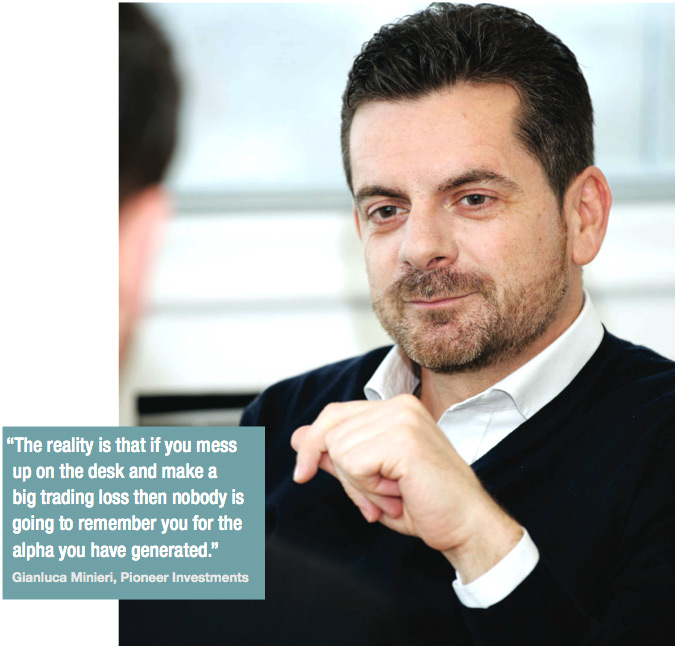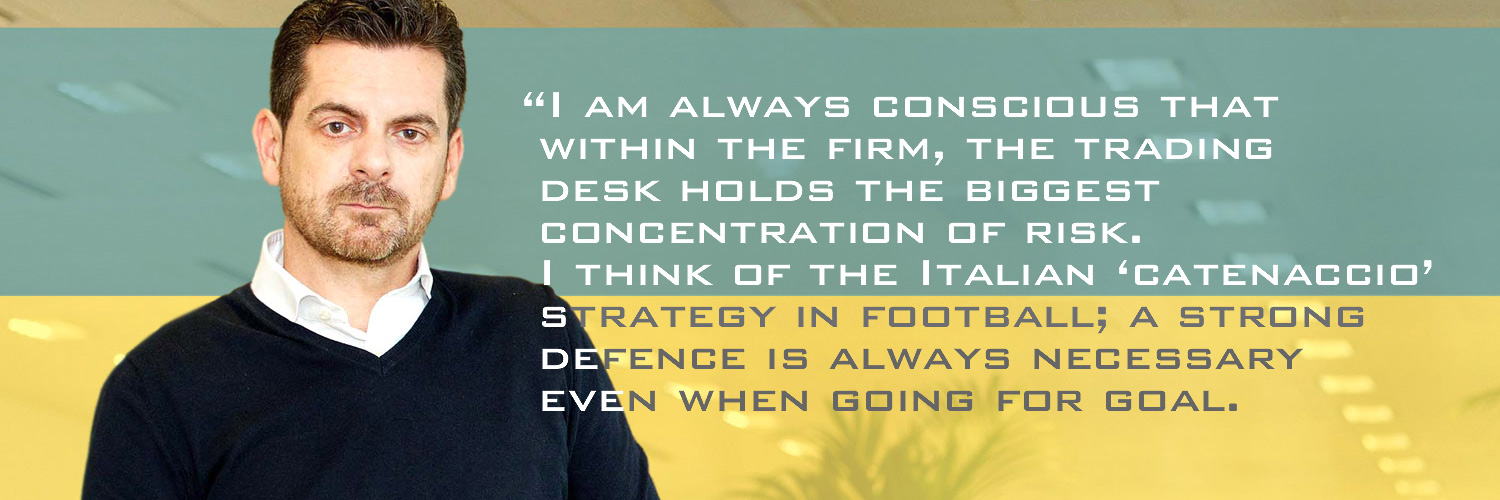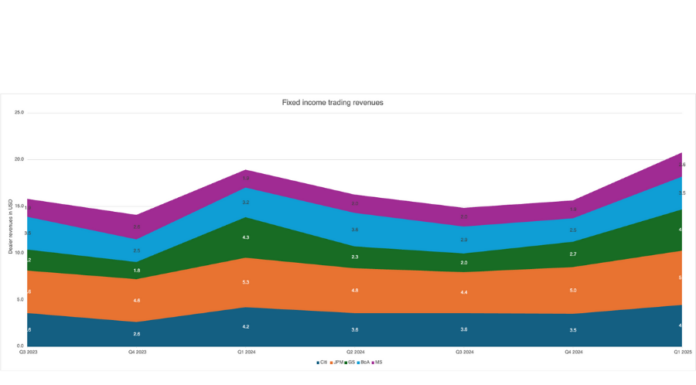The Greatest Concentration of Risk
Gianluca Minieri has been the global head of trading at Pioneer Investments since 2011, driving reform across trading operations, including the creation of dedicated fixed income trading roles where portfolio managers once dealt with brokers directly. Now the firm is in the process of expanding its traders’ roles to work across assets, taking advantage where markets carry similarities.
What are your strategic priorities as global head of trading?
The role of the trading desk in Pioneer has progressively evolved from a pure order-taking to a value-driver model, leading to a greater reliance on the trading desk across the investment team. Traders have become a consultant to fund managers in terms of how and when to execute a trade and where to take risk. When it comes to setting the priorities for my team, achieving best execution on behalf of our clients always sits above everything else, ensuring that best practises are adhered to.
With so many varied sources of information and complexity to deal with in terms of the liquidity paradigm, the role of the trader has become much more technical today. Our role is to carry out a diligent and meticulous activity of market intelligence, price discovery and search for liquidity, to identify the best way to execute a trade given market conditions and all relevant constraints. We add value to the investment process and create value for clients. To demonstrate the value that execution brings, traders’ performances are measured against a number of benchmarks using a transaction cost analysis performance indicators.
What is your approach to managing the trading team?
I am always conscious that within the firm, the trading desk holds the biggest concentration of risk. I think of the Italian ‘catenaccio’ strategy in football; a strong defence is always necessary even when going for goal. Managing a global trading operation with an annual volume in excess of US$700billion across asset classes and several jurisdictions is a responsibility that comes with its
challenges. That’s why I constantly emphasise to my team the critical importance to be alert at all times, to run our trading operations in line with all internal process and procedures and compliant with all relevant regulations. The reality is that if you mess up on the desk and make a big trading loss then nobody is going to remember you for the alpha you have generated.
How do you measure trading performance for bonds?
Over the last few years we have dramatically increased the amount of trading we do on electronic platforms – 90% of government bonds, 70% of investment-grade corporate bonds and 90% of FX. That creates a considerable amount of data that is running through the platforms. We liaise with the platforms’ data provider, then apply simple methodologies – for example on BondVision we will look at fill ratio, reject ratio, average size of fill in order to assess broker performance.
With voice orders, data is hard to gather and we don’t have a crystal ball so we have to use more qualitative benchmarks, which is where experience kicks in – you know when you are getting a good price. Furthermore, ensuring that brokers are in competition helps to get the best price. We have done a good job developing straightforward metrics to measure performance.
What is the skill set of the fixed income team?
Each trader in Pioneer has a set of core competencies, then a responsibility on a particular product or asset class. However, last year we took a decision to evolve our trading desk into a multi-asset operation. In some of the smallest hubs like in Milan and Munich we have already moved to a model where specialisation no longer exists and each trader covers both fixed income and equity. In Dublin we have seven traders – under the old model I had four in fixed income and three in equities but these people are now embedded into the same team. The change is still rolling out across other geographies – in London I have one trader focused on emerging markets fixed income and then in Boston we have two dedicated to fixed income.
It is not without boundaries – I won’t ever have a trader working emerging markets FI and small cap US equities – but there are a lot of similarities in certain areas and the way you execute on electronic platforms can be very similar.
That sounds like a very demanding model for the traders, how do you select and train them? I have been a trader my entire life and one thing a trader needs to have is a strict discipline and mindset in their approach to work. Everything else can be learned. Experience comes from doing the job. We’ve had success stories where we hired traders with FX backgrounds to cover different asset classes as we could appreciate the diligent and precise approach in managing trades, and we were right as they proved very strong in trading new asset classes.
Which tools do you use to enable the team to trade effectively?
We are connected via FIX to all of the major platforms, BondVision, Bloomberg, Tradeweb and MarketAxess for fixed income and FXall for foreign exchange.
We are also considering using the new BBX functionality within Bloomberg’s Trading Solutions Order Execution (TSOX). BBX is an all-to-all trading platform where each counterparty can trade anonymously facing each other via third party.
This is something that we are willing to start using, so an order is sent from our order management system (OMS) to the platform in the same way that an existing order is sent via TSOX. With the BBX functionality you have access to a fixed income dark pool, and if there is another side to the trade then the order is flagged and you have the option to engage with the other party and trade at the mid-price. This type of all-to-all platform is something that we are increasingly interested in. There are also various rules to prevent phishing with counterparties who do not trade inside their indicated price, facing temporary expulsion from the platform.
What platform do you use for order management?
Two years ago we made a big investment deploying the Aladdin OMS across all trading desks. It is a multi-asset OMS with an embedded execution management system (EMS) to provide connectivity with direct market access and algos in the same place. So once an order is on the blotter a trader has a lot of options in how to deal with it. The most important feature of Aladdin is the global infrastructure that we have employed to create a global central order book. We can route orders to local desks and execute in the local time zone leveraging on local market expertise. This will bring increased opportunity for merging, crossing and pooling orders. It also gives us the ability to support the growing demand for global multi-asset products where you may have emerging market, US fixed income and equity piece within the same product. Executing these asset classes leveraging on local expertise is a great advantage.”
What is the impact of market structure changes?
New regulations such as CRD4 and Basel III have limited the ability of the sell side to use balance sheet, making it extremely expensive for them to hold bond inventory. In addition there has been a prolonged period of a low interest rate environment which has reduced the profitability of the repo market, which is where market makers cover their position in the short term. There is a direct link between the repo market and liquidity in the bond and equity markets. These two factors, the increased cost of inventory and the reduced profitability of the repo market, have led to a dramatic decline in liquidity in the secondary bond market.
The temptation for regulators to transform the fixed income market into an equity market has been very strong but they have difficulty in acknowledging the difference between fixed income and equity. I believe if they could create a single venue on which fixed income trading would take place using an equities-style central limit order book they would do it tomorrow. Unfortunately that is impossible. I feel the extension under MiFID II of the equity transparency requirements into the fixed income market is symptomatic of the difficulty they have in understanding the difference.
How are you managing these challenges?
I think over the last few years the buy side has taken leadership in addressing these issues. It is a natural consequence of the consistent and progressive growth that the buy side has had of assets under management compared to the sell-side. The buy side is growing, the sell side is shrinking. A number of buy-side initiatives have already been launched. The objective is sourcing natural liquidity from holders of large dormant inventories. In order to do this you need some technological investment and no one single party can take that cost. So the buy side is looking at initiatives where there is a shared architecture and a new way of connecting between the buy-side and sell-side.
What needs to change?
A number of changes in the market are required. We cannot rely on the RFQ model as it is inefficient exactly when you need it. RFQ creates artificial liquidity. Any duplication of the same trades across the market or of false trading intentions is quite dangerous for the market. In addition the transparency requirements under MiFID II will make RFQ difficult because information dissemination will lead to market impact reduction in the average trade.
We, the buy side, have to decide which and how many platforms we want to join. It will be a survival battle. Many of these new initiatives will fail, others will succeed. In our opinion, the winning element will be an electronic platform that will be able to act as an aggregator of liquidity which is critical in the fragmented liquidity environment that we have today. On top of everything, we have to make sure that any conflicts of interest between the market participants and who is managing the platform is properly addressed. ■
■ Gianluca Minieri is the global head of trading where he oversees Pioneer Investments’ trading operations worldwide in Asia, the US and Europe. He is also the London branch manager at Pioneer Investment Management Limited. Prior to joining Pioneer Investments, Gianluca was the CEO and CIO of Monte Paschi Ireland Limited, where he set up and led a €1.7bn proprietary trading operation. Before joining Monte Paschi in 1999, Gianluca was responsible for proprietary trading at Banca 121 in Italy, where he previously held the role of head of risk management. Before this, he served as a consultant at Arthur Andersen.
Gianluca holds an MBA with the SAA Business School in Turin, and a specialisation in Finance through The Pace University and the Manhattan Institute of Management of New York. Gianluca holds a first-class honours degree in Economics and Banking Sciences. He is also a certified public accountant.
©TheDESK 2015
©Markets Media Europe 2025
























